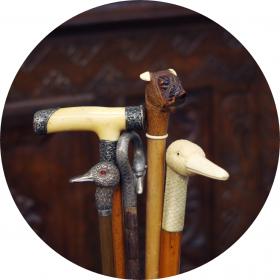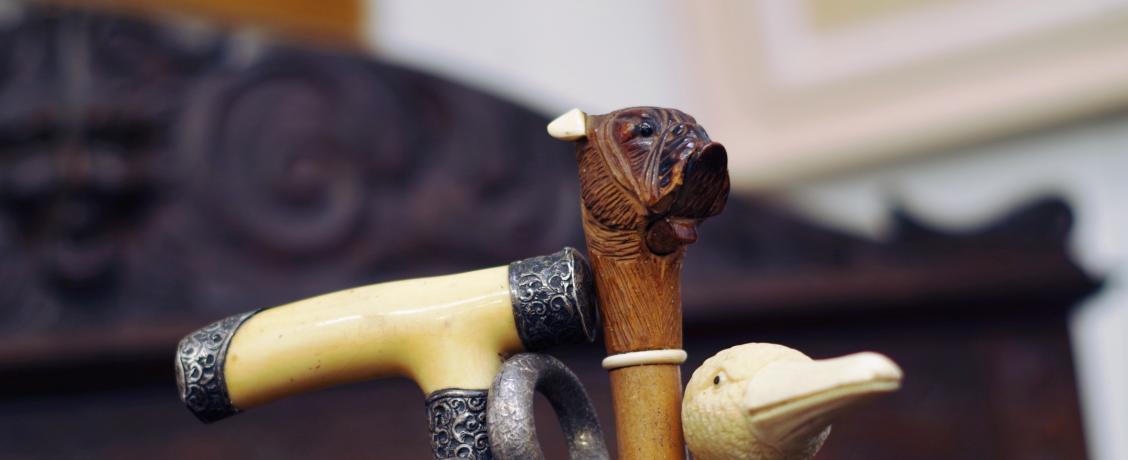Stick to What You Like
By Elizabeth Talbot
Step through the doors to the Waveney Room at Diss Auction Rooms next week and you will enter a wonderful array of fine antiques and artefacts, a veritable Aladdin’s Cave of tempting furniture, silver, works of art and ceramics in TW Gaze’s next Antiques Special sale on Friday 21 February; an engaging mix to entice astute collectors, artistic furnishers and canny bidders in equal measure. (There are four other separate auctions to explore on site at the same time, but that is another story).
Within this eye-catching, mouth-watering feast of delights lies a group of lots representing high-class functionality; pieces displaying an obvious sensitivity towards and appreciation of natural forms, which, combined with obvious humour, represent great examples of craftsmanship. I refer to five late Victorian/ Edwardian walking sticks, parasols and umbrellas with novelty handles. They include a silver swan’s head with glass eyes atop an elegant curved neck from 1902 and a similar duck’s head from 1890; there is a carved ivory duck’s head and a carved wood bulldog‘s head with articulated jaw. Guide prices range from £120 – 270.
Charming and tactile as they are, the condition and beauty of theses handles belies the fact they were intended as practical items to fulfil a physical functionality and studying them led me to consider the origin and history of these most humble of accessories.
For as long as primates and early man have picked up fallen branches, there have been hand-held sticks, the uses they fulfilled ranging from defence and combat to hunting tool and status symbol… he who held the stick was in charge… Walking sticks started out as a necessary tool for the Shepherd and traveller. A nice hefty stick was an excellent way to protect against thieves and to keep animals in line. Over time, the walking stick gradually began to be known as a symbol for power and strength, and eventually authority and social prestige.
Rulers of many cultures, past and present, have carried some form of walking stick or staff. Egyptian rulers were believed to have carried staffs varying from three to six feet in length. These were often topped by an ornamental knob in the shape of a lotus, a symbol of long life. Ancient Greek gods were often depicted with a staff in hand. By the Middle Ages, (in what is now Europe), a scepter carried in the right hand was a symbol of royal power, while one in the left hand represented justice. The church also began to use staffs to denote its higher offices. The use of the word “cane” for a walking stick appears to have begun in the 16th century, when bamboo and other tropical grasses and reeds started to be used as shafts.
By the 1600s gentlemen in the West began to carry canes as part of their everyday dress as a replacement for a sword. In the late 17th Century oak sticks were carried, especially by the Puritans. The fashion for men to carry sticks continued into the 18th Century and from time to time, women also carried walking sticks or canes as a fashion accessory.
New rules of etiquette were formed during this time. To break this code of behavior was considered a violation of good manners. By the early 18th Century the rules were becoming very serious: in 1702, the men of London were required to have a license in order to carry a walking stick or cane, thereby ensuring proper etiquette was observed, including how to hold it and when to lift it. Cane use was considered a privilege and gentlemen had to abide by those rules or lose the privilege. Holding a cane under-arm was considered improper use, and would forfeit a license.
As the decades passed, canes tended to become less functional and more ornate, with many novelty and specialised canes being produced. Canes which incorporated features such as hidden compartments, hip flasks, horse measurers, pool cues, spy glasses, walking compasses and sword canes are rarities and therefore highly sought after by collectors. As a point of interest, collectors of walking sticks are known as rabologists.
Likewise, the materials and themes chosen for manufacturer affect the desirability for collectors. Handles have been produced from many substances, both natural and man-made, from modest materials to luxurious and precious ingredients. Carved and decorated canes have turned the functional into the fantastic. Running parallel to this craft was the evolution of umbrella and parasol handles – equally creative, imaginative and amazing.
The relevance of the cane or stick was maintained during the development of the eclectic martial art of Bartitsu in England between 1898 and 1902 and was famously immortalised by Sir Arthur Conan Doyle in 1903 in one of his Sherlock Holmes stories. This was followed by the general acceptance of white canes to signify visual impairment during the 1930’s. James Biggs of Bristol claims to have invented it in 1921, after losing his sight and feeling vulnerable out and about; he painted his walking stick white to be more visible to motorists. Ten years later, in February 1931, Guilly d'Herbemont began a national white stick movement for the sight impaired in France. In May of the same year the British Broadcasting Company suggested that white sticks should be given out to the sight impaired, and that the white stick or cane should become a universal symbol to indicate that a person was blind or visually impaired. Gradually the significance of the white cane was absorbed into the government policy of many countries.
Walking sticks ceased to be a standard item in the wardrobe during the mid-20th Century, but in the 21st Century we seem to have re-embraced them as useful aids for mobility, good posture and health-conscious walking. Why not do all this in style and invest in the best?
Viewing: Thursday 20 February 2 – 8pm and on morning of sale from 8.30am. Sale starts at 10.30am.
Catalogues: twgaze.co.uk Bid online: the-saleroom.com
Enquiries: Harry Plowman and Edward Smith 01379 650306

